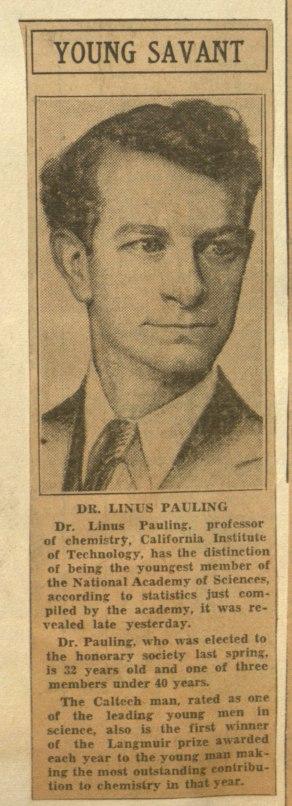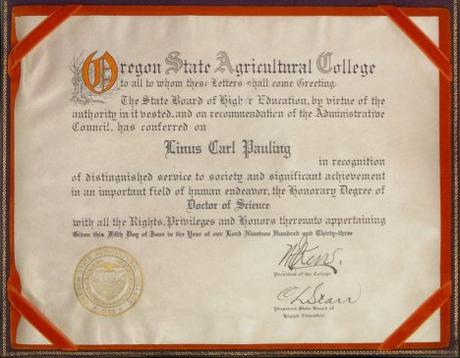
Linus Pauling at Oregon State Agricultural College in June 1933. The 1933 commencement program stated that Pauling was “now acclaimed among the distinguished scientists of our time.” Included in the photograph (left to right) are Dr. Marvin Gordon Neale, Commencement speaker; David C. Henny, honorary degree recipient; Pauling; Dr. William J. Kerr, Chancellor of the Oregon State System of Higher Education and OSAC president from 1907-1932; and Charles A. Howard, honorary degree recipient.
[Ed Note: This weekend is commencement weekend at Oregon State University, and to mark the occasion we thought we would look back at Graduation Day 1933 at Oregon State Agricultural College, a commencement exercise distinguished by Linus Pauling’s receipt of an honorary doctorate from his undergraduate alma mater.]
The early years of Linus Pauling’s academic career were marked by a dizzying array of accomplishments. Offered an assistant professorship by Caltech at the conclusion of his graduate studies in 1927, he was promoted to full professor just four years later. And by 1933, he oversaw twice as many graduate students and post-doctoral fellows as any other professor at the Institute.
His Caltech salary also increased substantially during this time, the result of his having received numerous offers from other institutions trying to pry him away from Pasadena. Since he was usually asked to teach only one seminar per term, he was also left with plenty of time to conduct research, often as a visiting professor at nearby universities.
Perhaps most notably, he had also won the first ever Langmuir Award, granted in 1931 for his research in structural chemistry. A.C. Langmuir, the brother of Nobel chemist Irving Langmuir, established the award for “outstanding chemical research,” defined to be work of unique merit conducted by an individual in the beginning stages of their career. In granting the award to Pauling, A.C. Langmuir recognized Pauling to be a rising star and predicted that he would one day win the Nobel Prize. In many respects, the award launched Pauling into the public eye.
Around this time, Pauling gave a seminar at Caltech on the quantum mechanics of the chemical bond that famously baffled Albert Einstein, who was in attendance. Not long after, Pauling became the youngest individual ever invited to join the National Academy of Sciences. It is no wonder then that Caltech’s chemistry chief A.A. Noyes remarked that Pauling was “the most promising young man with whom I have had contact in my many years of teaching.”

Pasadena Post, September 27, 1933
Where Pauling’s talent was coming to the attention of the broader scientific community in the late 1920s and early 1930s, Oregon State Agricultural College had recognized Pauling’s potential much earlier, during his years as an undergraduate. In May 1933, perhaps seeking to strike while the iron was hot, OSAC sent Pauling a telegram offering him an honorary doctorate of science, which would be his first. Despite the short notice, Pauling promptly and eagerly agreed to be present for the commencement ceremony, which would take place on June 5, 1933. Not long after, he hopped in his car and drove from Pasadena to Corvallis to partake in alumni events scheduled for the preceding weekend.
Recent changes at Pauling’s alma mater made this honorary degree all the more impressive. In 1932, the Oregon State Board of Higher Education established what was then called the Oregon State System of Higher Education to manage the affairs of colleges and universities in Oregon, an arrangement that remained in place for more than eighty years. Oregon State president William Jasper Kerr subsequently became the first chancellor of the system.
Over time, Oregon State University has both decentralized and simplified the process by which it decides to award honorary doctorates. In contrast, the decision to award Pauling his doctorate required the agreement of numerous individuals from the top of the system on down. Specifically, Pauling was recommended by the state system’s administrative council, approved by Chancellor Kerr, and endorsed by the board of higher education.

Pauling was one of three alumni to receive an honorary degree from Oregon State Agricultural College that year. The others were David C. Henry, a consulting engineer in Portland who received his honorary doctorate of Engineering, and Charles Howard, the state superintendent of public institutions in Oregon, who received an honorary Doctorate of Education. Dr. Marvin Gorden Neale, president of the University of Idaho, gave the commencement address that afternoon. In his speech, delivered in the early years of the Depression, Neale spoke of the need to fight against critics of the education system and to work to insure that support for land grant colleges and universities didn’t slip away.
When the moment came to introduce Linus Pauling, William Jasper Kerr listed off a string of accomplishments amassed since Pauling’s 1922 graduation from Oregon Agricultural College. In addition to the Languir Prize and the National Academy of Sciences admission, Kerr also emphasized Pauling’s achievements during his two years as a Guggenheim fellow, his authorship of over fifty scientific articles, and his appointment as a full-time professor at Caltech.
The evening report published in the Corvallis Gazette-Times newspaper leaned heavily on Pauling’s local roots and agreed with others’ assessment that Pauling’s future was bright. The paper also reported that 486 degrees were conferred at the 1933 commencement: 418 bachelor’s degrees, 52 graduate degrees, and 13 pharmaceutical chemistry diplomas.
OSAC Executive Secretary W. A. Jensen wrote to Pauling following the ceremony to confide that his award had been one of the most heartily endorsed doctorates he could remember. He also conveyed the encouragement and approval of Pauling’s burgeoning career that had been relayed by many on campus. Jensen concluded his memo with an increasingly common idea: “The Nobel Prize is just ahead!”
When Science published news of Pauling’s accomplishment, Fred Allen, another Oregon State alumnus, wrote Pauling to congratulate him. In his letter, Allen joked
I am proud that our alma mater could break away from the precedent which has stumbling over one’s beard a prerequisite to an honorary degree.
Indeed, Pauling was only 32 when awarded his first honorary doctorate, just eleven years removed from his undergraduate program. The two other recipients of honorary degrees at the 1933 graduation ceremony were decades older than Pauling.
Pauling would ultimately accumulate 47 honorary degrees over the course of his lifetime. For a man of such decoration, it would seem fitting that his first honorary degree came from his alma mater, a school that encouraged his passion for science well before he became nationally recognized. The honor captured an important moment in Pauling’s career and provided a glimpse of what was to come.
Advertisements